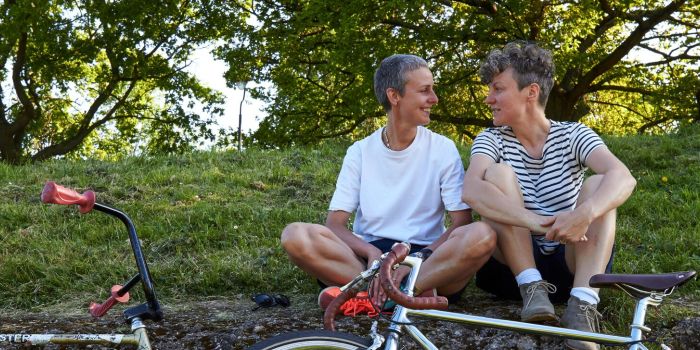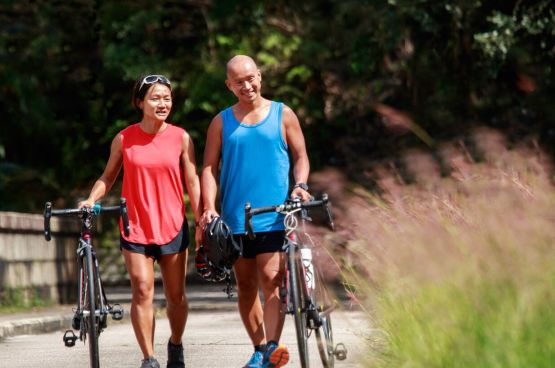What are the health benefits of cycling?
Cycling can be fun and enjoyable for all ages and abilities. It can also be a quick and eco-friendly way to get around. But what are the health benefits of cycling? Here I explore how cycling compares to other forms of exercise, such as running. I’ll also share the top five health benefits that cycling regularly can bring you.

Why is cycling so healthy?
Cycling is a great, low impact exercise. This means it doesn’t put unnecessary strain onto your muscles or joints. This makes it a good choice if you have health conditions such as arthritis. It can also help if you’re recovering from an injury.
Cycling gives you many different health benefits, making it an effective form of exercise. It’s also suitable for people with different fitness levels and accessibility needs. Also, cycling is cheaper and easier to do than many other forms of exercise – making you more likely to do it regularly.
The top five health benefits of cycling
Cycling has a wide range of health benefits, but here are the top five.
1. It improves your cardiovascular health
Cycling is a form of cardio exercise – this means it increases your heart rate and strengthens your lungs and blood vessels. People who cycle regularly have a lower risk of heart disease than those who walk or do gardening instead. This may be because cycling is a moderate intensity exercise. This means it strengthens your heart more than lower intensity activities such as gentle walking.
2. It can boost your mental health
Exercise has been shown repeatedly to improve mental wellbeing. And cycling is no exception. Biking outdoors may be particularly beneficial. This is because spending more time in nature is also good for your mental health. Cycling may also increase mental wellbeing in older adults too. A study comparing the mood of adults in care homes found they had a better mood on days they were taken for a bike ride.
3. It can strengthen your muscles and joints
As you age, you lose muscle mass and strength. This can cause problems such as weakness and pain in later life. Regular exercise, including cycling, can help to reduce some of these natural effects of aging. If you have arthritis, exercise is now recommended to reduce pain and other symptoms, such as stiffness. One study showed that after 12 weeks of cycling, people with knee arthritis reported significantly less pain and better mobility than those who didn’t cycle.
4. It can help you manage your weight
If you regularly cycle at a high intensity, you may be able to reduce your body fat stores. This can help you maintain a healthier body weight, especially if you also eat a balanced diet. Also, if you combine cycling with resistance-style exercises, you can increase your lean muscle mass and resting metabolic rate. When your resting metabolic rate is higher it means you burn more calories, even at rest.
5. It improves your balance and coordination
Having good balance and coordination are an important part of healthy aging. Helpfully, cycling can support you with this. Studies show that cycling three times a week for around 20 minutes can improve balance scores and walking pace in older women. This effect happened even when a stationary bike was used.
How does cycling compare to running?
Running is also a type of cardiovascular exercise with many health benefits. However, for some people, running can put a strain on their joints and muscles. This means a lower impact exercise such as cycling might be better. Cycling also has the added benefits of coordination and balance improvements too. Some people may find cycling a more enjoyable way to work out. Or you might like to alternate between running and cycling for more variety.
How much cycling per week is healthy?
The Chief Medical Officer in the UK recommends that all adults to do at least 150 minutes of moderate intensity exercise each week. This means doing cardiovascular exercise, such as cycling, for 30 minutes five times a week. But you’ll also need to add in 2-3 sessions per week of resistance training, such as weightlifting or yoga, to meet your weekly targets.
Do you know how healthy you truly are? Bupa health assessments give you a clear overview of your health and a view of any future health risks. You'll receive a personal lifestyle action plan with health goals to reach for a happier, healthier you.
-
Sources Sources
- Cycling and health. British Cycling, britishcycling.org.uk, accessed 17 August 2022
- Nystoriak A, Bhatnagar A. Cardiovascular effects and benefits of exercise. Front Cardiovasc Med 2018; 5: 135.28. doi: 10.3389/fcvm.2018.00135
- Hoevenaar-Blom M, Wendel-Vos G, Spijkerman A et al. Cycling and sports, but not walking, are associated with 10- year cardiovascular disease incidence: the MORGEn study. European journal of cardiovascular prevention and rehabilitation 2011;18: 41–47. doi: 10.1097/HJR.0b013e32833bfc87
- About physical activity. Mind. mind.org.uk, accessed 17 August 2022
- Thriving with nature. Mental Health UK. mentalhealth.org.uk, accessed 17 August 2022
- Grey R, Gow G. Cycling without age: Assessing the impact of a cycling-based initiative on mood and wellbeing. Gerontology and geriatric medicine 2020;6: 2333721420946638. doi: 10.1177/2333721420946638
- Volpi E, Nazemi R, and Fujita S. Muscle tissue changes with aging. Curr Opin Clin Nutr Metab Care 2004 Jul; 7(4): 405–410. doi: 10.1097/01.mco.0000134362.76653.b2
- What type of exercise should I do? Versus Arthritis. www.versusarthritis.org, accessed 17 August 2022
- Salacinski A, Krohn K, Lewis S et al. The effects of group cycling on gait and pain related disability in individuals with mild to moderate knee osteoarthritis: A randomised control trial. Journal of orthopaedic and sports physical therapy 2012;42:985-995. doi: 10.2519/jospt.2012.3813.https://www.jospt.org/doi/10.2519/jospt.2012.3813
- Kaya F, Nar D and Erzeybek M. Effect of spinning cycling training on body composition. Journal of Education and Training Studies 2018;6(4):154-60. Doi:10.11114/jets.v6i4.3028
- Del Vecchio L, Reaburn P, Meerkin J et al. Concurrent strength and sprint training increases resting metabolic rate and lean mass in masters road cyclists. Movement and Sports Sciences - Science et Motricite 2020;109:39-50. DOI:10.1051/sm/2020007
- Lee C, Cho G. Effect of stationary cycle exercise on gait and balance of elderly women. J Phys Ther Sci 2014;26(3):431–433. doi: 10.1589/jpts.26.431
- Hespanhol C, Pillay J, Mechelen W et al. Meta analyses of the effects of habitual running on indices of health in physically inactive adults. Sports Med 2015; 45(10): 1455–1468. doi: 10.1007/s40279-015-0359-y
- Physical activity: applying all our health. Office for Health Improvement and Disparities. gov.uk, updated 10 March 2022
About our health information
At Bupa we produce a wealth of free health information for you and your family. This is because we believe that trustworthy information is essential in helping you make better decisions about your health and wellbeing.
Our information has been awarded the PIF TICK for trustworthy health information. It also follows the principles of the The Information Standard.

More exercise and fitness articles
Did you find our advice helpful?
We’d love to hear what you think. Our short survey takes just a few minutes to complete and helps us to keep improving our healthy lifestyle articles.
Legal disclaimer
This information was published by Bupa's Health Content Team and is based on reputable sources of medical evidence. It has been reviewed by appropriate medical or clinical professionals and deemed accurate on the date of review. Photos are only for illustrative purposes and do not reflect every presentation of a condition.
Any information about a treatment or procedure is generic, and does not necessarily describe that treatment or procedure as delivered by Bupa or its associated providers.
The information contained on this page and in any third party websites referred to on this page is not intended nor implied to be a substitute for professional medical advice nor is it intended to be for medical diagnosis or treatment. Third party websites are not owned or controlled by Bupa and any individual may be able to access and post messages on them. Bupa is not responsible for the content or availability of these third party websites. We do not accept advertising on this page.







